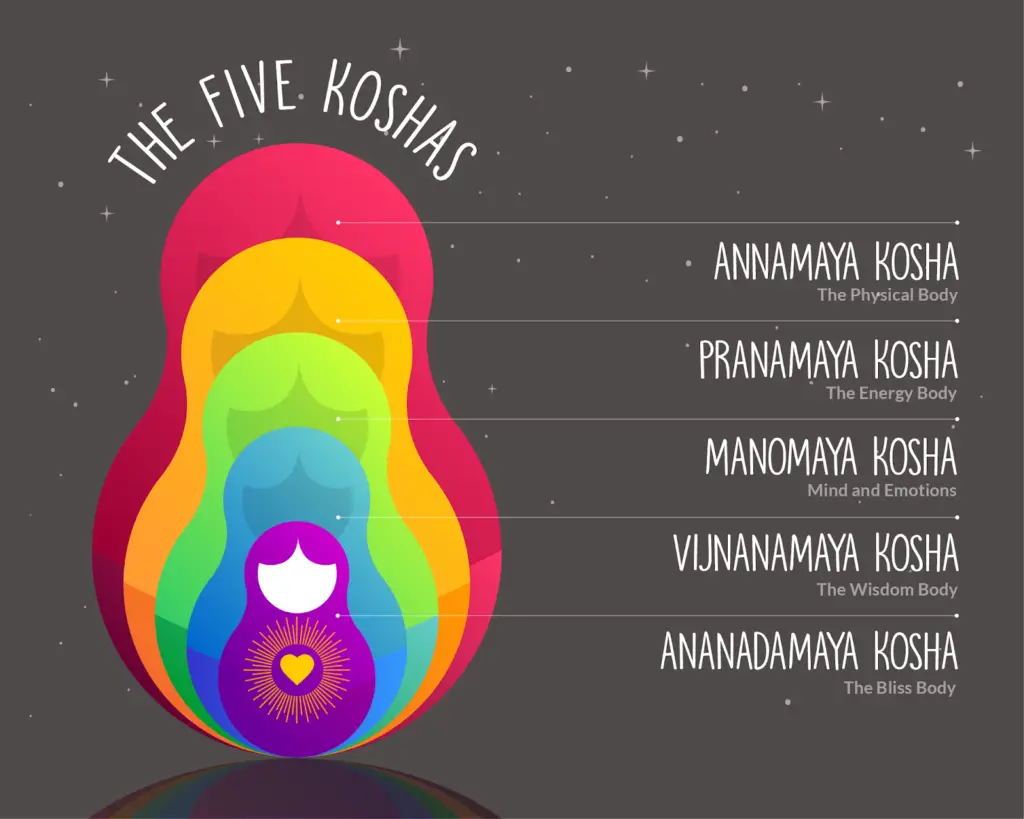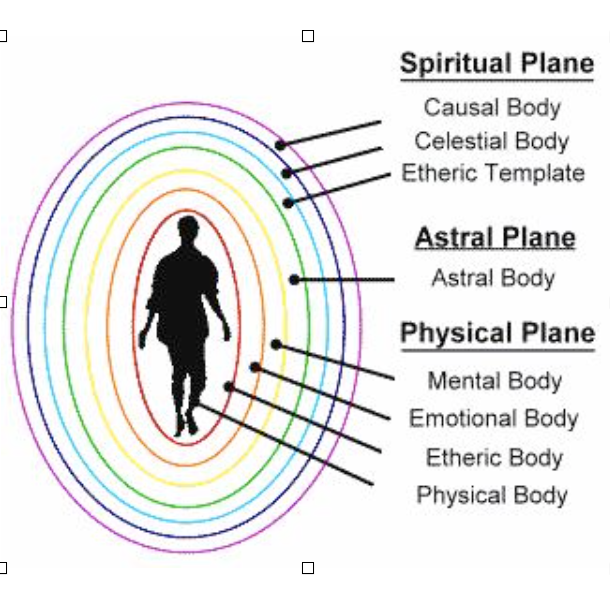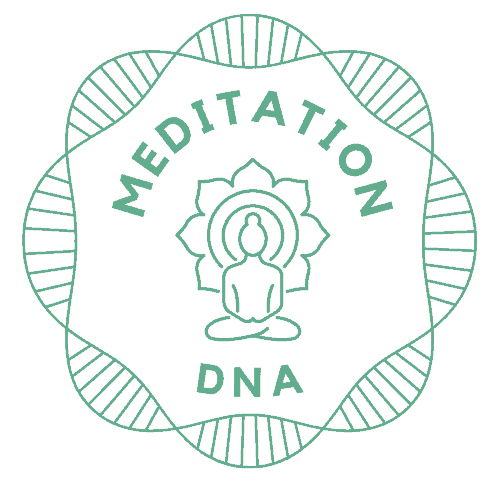
Yoga Koshas – the layers of being
In this article, we will look at the concept of the five energy layers of the body (physical, energetic, mental, intellectual, and spiritual) and how they relate to meditation and mindfulness.
Let’s start with understanding what the Yoga Koshas are…
What is Kosha?
In Sanskrit, the word “kosha” means layer or sheath. It refers to the different levels of energy that exist within us. Our physical body has three main layers: the physical, emotional, and mental. Within those layers lie our energetic bodies, which include the etheric, astral, and causal bodies.
These layers act as a container for our consciousness, and we experience ourselves through these layers. The koshas make up the ‘Atman’ which in Sanskrit refers to the ‘Soul’ or ‘Self‘.
The koshas regulate how we feel physically, psychologically, and spiritually. By working with the koshas, we can change our lives and reach a state of peace and balance.
We use the word kosha to refer to these three main bodies (etheric, astral, and causal), which are made up of physical, vital, and subtle energies.
Each of these bodies has its unique qualities and characteristics. They are all connected, making up our total system (Atman).
All of these bodies need to be balanced for true well-being and practices such as yoga, meditation, and mindfulness techniques (like breathwork) help us come into energetic equilibrium.
Physical Body – Physical Body is made up of the five elements: earth, water, fire, air, and ether. These elements correspond to the different organs in the body. In yoga, our physical ‘asana practice’ focuses on aligning the physical body.
Etheric Body – Etheric Body consists of five subtle energetic layers that surround the physical body. They correspond to the vital forces that control all of our actions and behaviors.
Astral Body – Exists between our intelligent body and mental body.

The subtle layers
So what are the different layers of energy, and how do they relate to meditation and mindfulness.
Five Kośas pronounced Koshas of our existence
The five koshas are (ordered from least subtle to most subtle – outermost layer to innermost layer):
Physical body – Annamayakosha
Vital and energetic Body – Pranamayakosha
Mental body – Manomayakosha
Intuitive and wisdom body – Vijnanamayakosha
Spiritual or bliss body –ānandamayakosha
Annamayakosha – the physical or food sheath
This is the layer of matter that covers the physical body. ‘Anna’ means food or physical matter. It contains the organs of digestion, elimination, respiration, circulation, and excretion. This layer holds all bodily functions together. It includes all connective tissue, bones, muscles, nerves, organs, and anything else about the physical human body. If there is blockage or stagnation anywhere, then there is a corresponding effect on the rest of the body.
Pranamayakosha – the vital energy life force sheath
Yoga also makes you aware of a second body, the organizing field that holds your material body together. This is the life energy that governs your biological processes, from breathing to digestion to the circulation of your blood. It’s called chi in Chinese medicine and prana in yoga. The ancient Egyptians called it the ka. (yogainternational.com)
Yoga teaches us how to control our breath, and this controls our life force, energy, or prana. Chi or prana helps us heal ourselves by circulating throughout our bodies.
Homeopathy and acupuncture are both based on the idea that we are more than our bodies. They can help us overcome disease by stimulating the vital force that powers our bodies.
Pranayama are breathing practices used to increase the life force of the pranamayakosha.
Diaphragmatic breathing is a specific type of pranayama that increases the life force of the second sheath. Complete yogic breath is another type of pranayam that improves the functioning of the second sheath of pranamaya kosha. Alternate nostril breathing is a third type of pranayam that enhances the functioning of the second kosha.
Sunlight and fresh whole foods are a great source of prana.
In the context of meditation, prana (or life force) is one of the three main components of consciousness. The flow of prana refers to the energy that flows through us and animates all living things. This energy is present at every level of existence and is what gives life meaning.
Manomayakosha – the mental sheath
This is the layer of the thinking mind. Our inner mental narrative, thoughts, feelings, etc.
The third sheath or mental layer is the apparatus responsible for sensory and motor functions and our daily awareness while we’re operating on auto-pilot. It processes input from our 5 senses and responds reflexively to stimuli.
Our mind is focused here when we function passively, reacting to our surroundings rather than actively shaping them. We call this mental state manomayakosha.
An example of manomaya at work is a patient that is in a coma. We see that the mind is active even though the physical body is inactive. The mind is working while the body rests.
The health of the manomayakosha is greatly enhanced by the practice of mantra meditation, which soothes and balances this internal body. Yogis who spend long periods meditating often have very little need to sleep, as their mental vehicles are functioning well. Their minds are tuned in to what is happening around them.
Our thoughts and emotions affect the energy flow in our bodies, which in turn affects our energetic and physical health. So, by becoming more aware of our thoughts, emotions, and judgments as they arise and dissolve, we can deeply enhance the state of our overall wellbeing by giving space to all of these thoughts and emotions through meditation or dhyāna.
A lot of people think of meditation as sitting still and doing nothing. But it’s quite different from this. Meditation is all about being fully present and aware of what’s going on around us. It’s about bringing awareness to every single moment of our life. It’s about becoming aware of and building up our manomayakosha energy.
A harmonious environment offers an ideal diet for the mental body. A daily session of sensory withdrawal followed by meditation provides an excellent inner tuning-up.
Vijnanamayakosha – the intellect & intuitive sheath
Permeating the three denser layers is the home of our intuition and inner wisdom. It is here that we receive messages from beyond the realm of our understanding. Through the practice of asanas, prānayāmas, dhāraṅā, and dhyāna, the mind becomes calm and we can listen to the silent messages that we are receiving from life.
Vijnana means intellect. It encompasses all the functions of the Higher Mind. It may be easier for people to understand the difference between the 3rd sheath and the 4th sheath by looking at people whose intellects are underdeveloped. People who don’t make decisions and respond reactively are victims of their bad judgments. They have very little willpower and are constantly victims of their own poor choices.
An activated fourth sheath is what separates humans from animals. Only humans can direct their own lives, and make moral choices. The goal is to understand these truths about ourselves and our minds. Meditation helps us learn how to use our minds to achieve goals and tap into this intuitive intellect. We become calmer when we meditate, and we gain better control over our thoughts. This leads to clearer thinking and better decision-making.
Where manomaya may refer to our thoughts Vijnanamaya refers to the layer beneath those thoughts of conscious awareness.
Resting in your true nature allows you to hear messages from life. You rest in your true nature when you are calm and relaxed. Your true nature is your soul. When you are calm and relaxed, you allow yourself to be more open to receiving messages from life.
But why does this matter? Well, if we want to understand how to tap into a meditative state, we need to understand what makes us tick. And understanding ourselves better means being able to access our inner wisdom.
Anandamayakosha – the bliss sheath
Beyond the other 4 koshas, and yet permeated and comprising them all, the bliss layer is the fifth and most subtle. The deepest layer.
Ananda means bliss or joy.
This is the aspect within us that we recognize as a state of deep inner peace and joy. It is free from our thoughts, feelings, emotions, and energy, and yet at the very same time embracing them all, and so it is the state of being that we are.
It is the sweetness that we feel when the mind is still, also known a sat-cit-ānnā or absolute truth-wisdom bliss. It can be known by the term super-conscious state and is activated through deep meditation.
When we refer to Monks or longstanding meditation practitioners reaching a sense of enlightenment this is the state that is usually tapped into and experienced.
Most people aren’t even aware that there is such a thing as spiritual bliss. Only saints, sages, or true mystics mostly experience ananda. Most people are barely aware that there is such an existence. We can awaken our bliss sheaths by doing selfless service, devotion to a higher power, and intense meditation. These practices open our hearts to our innate unity with each other and the universe.
Experiencing Your Five Sheaths
We mentioned before that health is holistic and when we can give ourselves the inner work by experiencing and building all five sheaths we experience life on a whole new conscious and awakened level.
Explore the layers of your body and soul through meditation
It is important to understand the concept of the energetic layers of the body and mind because they provide a framework for understanding what we mean by “mindfulness” and “meditation.” In addition, this model helps us understand why certain practices like meditation and yoga may not always lead to immediate results.
There is a reason that these energetic layers are referred to as subtle. The work we do across these layers are subtle but with profound effects.
Some people that want to dive deeper into learning about their koshas attend the Kosha Yoga School located in Sioux Falls, United States.
More on Manomaya Kosha and the Mental Body
In meditation, we tap into the mind-body connection by focusing on breathing and clearing away all distractions. This allows us to focus on the present moment and our inner mental landscape.
By tapping into our mind we tap into how this relates to us physically – much like the mind-body connection all our koshas exist individually but they are interwoven just the same.
Meditation relates to the manomaya kosha because the mind has two functions: thinking about things and feeling emotions. The manomaya kosha is the layer of our being that controls these thoughts and feelings. When we think too much or feel too much, we suffer from stress and anxiety.
By practicing mindfulness, we learn how to control our minds and not let them run away with us. When we meditate, we become aware of what is happening inside our minds.
Through meditation, we, therefore, train this part of ourselves and strengthen this energetic layer.
Although meditation is directly linked to the mental body it can be used to bring awareness to all the other kosha sheaths too.
In short, understanding our different energetic layers allows us to experience a whole new level of conscious awareness towards our being. We realize we are so much more than our physical selves and this can bring a lot of clarity to the way our minds work. The connection between the koshas, meditation, and mindfulness is very clear, and doing the inner work on all 5 of these planes provides us with a whole new awakened and spiritual experience.



